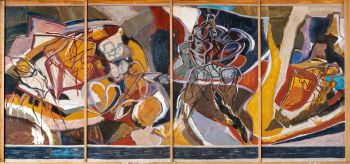News
Hope Wolf’s new exhibition, Sussex Modernism, opens at the Towner Eastbourne
Posted on behalf of: Faculty of Media, Arts and Humanities
Last updated: Wednesday, 25 June 2025

Ivon Hitchens, Day’s Rest, Day’s Work, 1960. Wax and oil on four panels, 365.6 × 731.5 cm. University of Sussex. All rights reserved, DACS 2024.
Dr Hope Wolf from the Faculty of Media, Arts and Humanities has curated a new exhibition at the Towner Eastbourne, Sussex Modernism. The exhibition runs from 23 May to 28 September 2025.
The show has been developed from Wolf’s research and recent book of the same name, Sussex Modernism, published by Yale University Press in 2025. For the development and completion of this book on and around the themes of Sussex Modernism, which includes a chapter on the University of Sussex in the 1960s, Wolf was awarded a Paul Mellon Mid-Career Fellowship in British Art for 2021-2022.
Co-Director of the Centre for Modernist Studies, Hope places the new Sussex Modernism exhibition in the context of her research; "I have been working on the Sussex Modernism project for a long while. When I started, I knew about the famous groupings, but I have since found out so much more by spending time in many archives and regional collections. I am now telling a new story which stretches from the late 19th century to now."
Exploring the works of artists associated with different modernist movements, bringing together artists who made work in rural, coastal, wooded and urban parts of the region, this exhibition compares their different ideas about how art should be made and life lived. It features fine art, pop, and counterculture, and a range of different media: painting, sculpture, film, photography, textiles, literature, and music. The show traces artworks' varied, and sometimes conflicting, relationships to different modernist movements, telling an original account about the ways in which art, cultures, and places outside of metropolitan centres have been seen.
This collection of works also conveys how working with regional collections can offer ways of challenging the canon, bringing into the story of modernism artists who had local or regional rather than national power. Many of these artists were women and neglected from canonical histories, and Wolf’s work considers Amy Sawyer in Ditchling, Mary Stormont in Rye, and Margaret Benecke in Eastbourne.
Whilst some modernists used 'provincial' as an insult, Wolf thinks about artists who aligned with the regions as a means of opposing national policy. She introduces the idea of 'new regionalism' (used by Clive Bell in 1941 when giving a speech that opened a new gallery in Lewes), and she considers why Harold Mockford declared himself a 'provincial artist' in the later part of the 20th century.
Alongside rural-based modernists’ work that may be most familiar to visitors, the show includes late flourishings of Dada and Surrealism in urban-based countercultures of the 1960s-80s, thinking through the work Jeff Keen made on Whitehawk rubbish tip near Brighton, Arnold Daghani in Hove, Edward Burra in Hastings.
The relationship between the Neo-Naturists and surrealism is also considered, and there are many contemporary artists in the show, including Sophie Barber, Larry Achimpong, Becky Beasley, A T Kabe Wilson, Ane Thon Knutsen, Margaret Scott, Geraldine Swayne, Nancy Odufona, John Stezaker, Alexi Marshall, Delaine Le Bas, Damian Le Bas, Laetitia Yhap, Poppy Jones, Christine Binnie, and Jennifer Binnie. Some of these works explicitly engage with early forms of modernism, while in others, different modernisms continue to reverberate.
By way of contrast, those who chose to work in a very different way also feature, placing modernism alongside those who chose not to embrace the 'new' and the 'now'.
In each instance, however, the exhibition attends to the artist’s relationship to Sussex and how they used their locations to reimagine how art might be made and life lived. Wolf compares the very different ways in which artists felt about place and their very different attitudes to life; "I think about the relationship between modernists and their artistic neighbours, who did not always have the same attitudes to art, place, and politics." The exhibition shows places to be multi-storied, always and ever in flux.
Programmed alongside the exhibition are events that feature other Media, Arts and Humanities research projects. Sussex Retold, a research strand of the Centre for Life History and Life Writing, are holding a day-course at the Towner on Saturday 31 May that will explore the art and literature of Beachy Head and the Seven Sisters, facilitating visual responses to Charlotte Smith’s nineteenth-century poem. Additionally, the concluding event of Professor Ed Hughes’ Arts Council England-funded project, From Felpham to Beachy Head, takes place on Sunday 13 July at the gallery and will be an intimate afternoon of live ensemble music from the South Downs Songbook.
Visit the Towner website to find more information about the Sussex Modernism exhibition and accompanying programme of events, and to book your place.